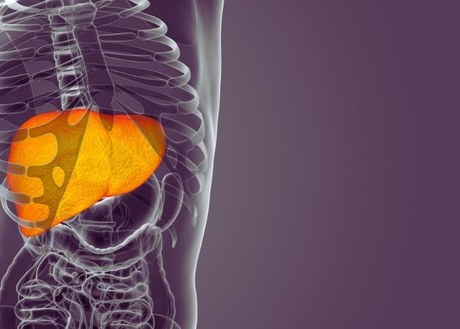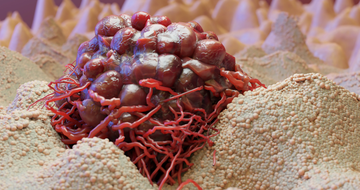FDA grants accelerated approval to futibatinib for cholangiocarcinoma
What is the potential role for futibatinib in the treatment of unresectable or metastatic cholangiocarcinoma?
- The prognosis for advanced cholangiocarcinoma is poor with less than 10% overall survival at 5 years.1
- Futibatinib is approved for the treatment of adult patients with previously treated unresectable or metastatic cholangiocarcinoma with a fibroblast growth factor receptor (FGFR) 2 gene fusion or rearrangement.2
- Futibatinib covalently binds to FGFR 1, 2, 3 and 4 and inhibits FGFR phosphorylation. This results in a decrease in FGFR signaling and a decreased proliferation of cells expressing FGFR genetic mutations.
- The preferred treatment for subsequent-line unresectable or metastatic cholangiocarcinoma is chemotherapy. However, there are several molecular alterations found in cholangiocarcinoma that have actionable targets, including FGFR2 rearrangements. FGFR2 fusions or rearrangements can be found in 10 to 16% of intrahepatic cholangiocarcinomas.3
- Futibatinib was granted accelerated approval based on a multicenter, open-label, single arm trial (FOENIX-CCA2) which included adult patients who had been previously treated with at least 1 prior line of systemic therapy for their unresectable or metastatic cholangiocarcinoma and harbored FGFR2 fusion-positive or FGFR2 rearrangement-positive tumors.5 Patients who were previously treated with a FGFR inhibitor were excluded from the study.
- Intervention
- 103 patients received futibatinib 20 mg orally once daily.
- Primary endpoint
- Objective response (complete or partial response) was 42% (95% CI, 32-52).
- Intervention
- Secondary endpoints
- Median duration of response: 9.7 months.
- Median progression free survival: 9 months.
- Median overall survival: 21.7 months.
- Safety and patient-reported outcomes
- All grade adverse events (AE) that occurred in 25% or greater of the patients:
- Hyperphosphatemia (85%)
- Alopecia (33%)
- Dry mouth (30%)
- Diarrhea (28%)
- Dry skin (27%)
- Fatigue (25%)
- All grade adverse events (AE) that occurred in 25% or greater of the patients:
- Common grade 3 AE: hyperphosphatemia (30%), increased aspartate aminotransferase level (7%), stomatitis (6%), and fatigue (6%).
- Common grade 1 and 2 AE: nail toxicities including onycholysis, discoloration, onychomadesis (47%), and retinal disorders (8%).
- Dose modifications due to AE:
- Dose interruptions: 50%
- Dose reductions: 54%
- Drug discontinuation: 2%
- No treatment-related deaths reported.
- Infigratinib and pemigatinib are both reversible inhibitors of FGFR 1-3 at the ATP-binding site of the FGFR kinase domain. They are approved for adult patients with previously treated unresectable or metastatic cholangiocarcinoma with a FGFR2 mutation.4
- Infigratinib was approved based on a phase II trial with a primary endpoint of objective response, which was 23.1%.6
- Pemigatinib was approved based on the phase II FIGHT-202 trial with a primary endpoint of objective response, which was 35.5%.7
- The binding site and affinity of futibatinib is different from that of infigratinib and pemigatinib. Its covalent bond with a cysteine residue within the FGFR kinase domain provides resistance against on-target resistance mutations.5
- The National Comprehensive Cancer Network (NCCN) guidelines recommend molecular profiling for all patients with either intrahepatic or extrahepatic cholangiocarcinoma. In patients with gallbladder cholangiocarcinoma, the NCCN recommends consideration of molecular testing. In adult patients with a discovered FGFR2 fusion or rearrangement, the NCCN recommends futibatinib or pemigatinib as category 2A treatment options in the subsequent-line setting.4
What role can the pharmacist play in the management of patients on futibatinib?
- Dosing information:
- Dosage form: 4 mg tablets.
- Dose: 20 mg (five 4 mg tablets) by mouth with or without food daily at the same time each day. If a dose is missed by 12 hours or more, or if there is vomiting, the missed dose should not be taken. Dosing should resume at the next scheduled dose.
- Futibatinib is provided in a blister pack where each row contains the five tablets for one daily dose. Each card in the blister pack contains enough tablets for one week of therapy. There are 4 cards in each blister pack.
- Tablets should be swallowed whole. Tablets should not be manipulated (chewed, dissolved, crushed or split).
- No differences were seen in systemic exposure of futibatinib in patients with mild to moderate renal (creatinine clearance between 30 mL/min and 89 mL/min) or mild hepatic impairment (aspartate transaminase above the upper limit of normal (ULN) or total bilirubin up to 1.5 times ULN). Patients with severe renal impairment (creatinine clearance below 30 mL/min) or moderate to severe impairment (total bilirubin greater than 1.5 x ULN) has not been studied; therefore, no dosage adjustment recommendations are available for these patients.
- Futibatinib is a substrate of CYP3A and P-glycoprotein/ABCB1. It is also an inhibitor of P-glycoprotein and BCRP/ABCG2.
- Inducers and inhibitors of CYP3A or P-glycoprotein may decrease or increase serum futibatinib concentrations, respectively.
- Concomitant use of P-glycoprotein and CYP3A inducers should be avoided.
- Futibatinib may increase the concentration of other drugs that are substrates of P-glycoprotein or BCRP/ABCG2.
- Avoid grapefruit products while taking futibatinib.
- Adverse events 4
- Hyperphosphatemia occurred in 88% (grade 1-3) of patients in the trial. There were no grade 4 hyperphosphatemia events, deaths, or drug discontinuations due to hyperphosphatemia.5
- Symptoms: Elevated serum phosphate (≥5.5 mg/dL), muscle cramps, numbness or tingling around the mouth.
- Median onset: 5 days (range 3 to 117 days).2
- Monitoring: Periodic monitoring throughout treatment. Once serum phosphate is elevated, monitor levels weekly.2
- Management1
- Serum phosphate ≥ 5.5 to ≤ 7 mg/dL: Low phosphate diet and phosphate lowering therapy should be initiated.
- Serum phosphate ≥ 7 to 10 mg/dL: Decrease futibatinib dose by 1 dose level (16 mg orally once daily)
- If serum phosphate is 7 mg/dL or below within 2 weeks, continue futibatinib at the reduced dose.
- If serum phosphate is still elevated above 7 mg/dL in 2 weeks, decrease futibatinib dosing to 12 mg orally once daily.
- If the serum phosphate is still greater than 7 mg/dL after the 2nd dose reduction, futibatinib should be withheld until the serum phosphate resolves to less than 7 mg/dL. At that point, treatment can be restarted at the dose prior to withholding.
- Serum phosphate ≥ 10 mg/dL: Hold therapy until serum phosphate is less than or equal to 7 mg/dL, then resume at 16 mg orally once daily.
- Discontinue futibatinib if serum phosphate is greater than 7 mg/dL within 2 weeks after 2 dose interruptions/reductions.
- Retinal Pigment Epithelial Detachment (RPED) occurred in 9% of patients in the trial.5
- Symptoms: blurred vision.
- Median onset: 40 days2
- Monitoring2
- Baseline comprehensive ophthalmological examination including optical coherence tomography (OCT)
- First 6 months: every 2 months
- After the initial 6 months: every 3 months
- Management2
- Upon visual changes, patients should be referred for an ophthalmologic exam with a follow up exam every 3 weeks until symptoms have resolved.
- If the visual symptoms resolve within 14 days, futibatinib may be resumed at the current dose. If the visual changes do not resolve within 14 days, then futibatinib should be held until symptoms resolve then treatment resumed at previous or lower dose.
- Hyperphosphatemia occurred in 88% (grade 1-3) of patients in the trial. There were no grade 4 hyperphosphatemia events, deaths, or drug discontinuations due to hyperphosphatemia.5
- Financial assistance may be available for commercially insured and uninsured/ underinsured patients. More information can be obtained by contacting Taiho Oncology Patient Support at 844-775-CARE (844-775-2273) or visiting their website at Cost Assistance | LYTGOBI (TaihoPatientSupport.com).8
- The patient leaflet can be found here: LYTGOBI patient brochure
Clinical Pearls
- Futibatinib is available as a film-coated 4 mg tablet. The recommended dosage is 20 mg orally at the same time daily. Tablets should be swallowed whole and not crushed, dissolved, chewed or split.2
- Grapefruit products should be avoided while the patient is on futibatinib.
- If it has been 12 hours since the missed dose or if the patient vomits after taking the dose, therapy should resume at the next scheduled dose. Do not take extra tablets to make up the missed or vomited dose.2
- The tablets should be stored at room temperature, 68⸰F to 77⸰F (20⸰C to 25⸰C).2
- Molecular testing for FGFR2 fusion or rearrangement is recommended for all patients with intrahepatic or extrahepatic cholangiocarcinoma. Molecular testing should be considered for patients with gallbladder cholangiocarcinoma.4
- There is no FDA or manufacturer guidance on the selection of the molecular assay test. The FOENIX-CCA2 trial identified patients with FGFR2 molecular aberration using a 324-gene-panel assay (i.e. FoundationOne CDx assay, Foundation Medicine).5
- Patients with a history of retinal disorder or altered non-tumor-related calcium-phosphorous homeostasis were not included in the FOENIX-CCA2 trial.5
- Patients with a serum phosphate ≥5.5 mg/dL should be counseled on restricting dietary phosphate intake. Foods high in phosphate include but are not limited to dairy products, organ meats and processed foods, such as chocolate, hot dogs, and deli meats.9
- Financial assistance may be available for commercially insured and uninsured/ underinsured patients through Taiho Oncology Patient Support.8
References
1.Goyal L, Konpetch S, Crolley VE, Bridgewater J. Targeting FGFR inhibition in cholangiocarcinoma. Cancer Treat Rev. 2021;95:102170.
2.Lytgobi (futibatinib) [prescribing information]. Princeton, NJ: Taiho Oncology, Inc.; 2022.
3.Jain A, Borad MJ, Kelley RK, et al. Cholangiocarcinoma with FGFR genetic aberrations: a unique clinical phenotype. JCO Precis Oncol. 2018;2:1-12.
4.National Comprehensive Cancer Network. Biliary Tract Cancers (Version 2.2023). Available at https://www.nccn.org/professionals/physician_gls/pdf/btc.pdf. Accessed June 23, 2023.
5.Goyal L, Meric-Bernstam F, Hollebecque A, et al. Futibatinib for FGFR2-rearranged intrahepatic cholangiocarcinoma. N Eng J Med 2023;388:228-239. DOI: 10.1056/NEJMoa2206834.
6.Javle M, Roychowdhury S, Kelley RK, et al. Infigratinib (BGJ398) in previously treated patients with advanced or metastatic cholangiocarcinoma with FGFR2 fusions or rearrangements: mature results from a multicentre, open-label, single-arm, phase 2 study. Lancet Gastroenterol Hepatol 2021;6:803-815. DOI: 10.1016/S2468-1253(21)00196-5.
7.Abou-Alfa GK, Sahai V, Hollebecque A, et al. Pemigatinib for previously treated, locally advanced or metastatic cholangiocarcinoma: a multicentre, open-label, phase 2 study. Lancet Oncol. 2020;21(5):671-684. DOI: 10.1016/ S1470-2045(20)30109-1.
8.Taiho Pharmaceutical Co., Ltd. Patient Support. LYTGOBI® (futibatinib) Tablets Patient Support and Cost Assistance. https://www.lytgobi.com/support-resources/cost-assistance. Published April 2023. Accessed June 23, 2023.
9.National Kidney Foundation, Inc. Phosphorus and Your Diet. https://www.kidney.org/atoz/content/phosphorus. 10.Published 2023. Accessed June 29, 2023.



